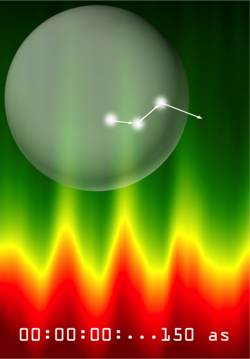The researchers sent flashes of light to a glass particle about 50 nanometers thick, which lasted only a few hundred attoseconds and released electrons in the glass. At the same time, the researchers irradiated an intense field of light onto the glass particles, which had only a few femtoseconds (millionths of a billionth of a second) and caused the released electrons to vibrate. In principle, two different reactions of the electrons could occur in the sequence. First they set in motion, then they collide with the atoms from the particle either elastically or inelastically. Between each interaction, the electrons could move only a few angstroms (10-10 meters) due to the dense crystal lattice. "In an elastic collision, as with billiards, the energy of the electron is conserved, only the direction can change, in an inelastic collision the atoms are excited and part of the energy of the electrons is lost, which means a decrease in the electron signal for the experiment. which we were able to measure ", describes Prof. Francesca Calegari (CNR-IFN Milan and CFEL / University of Hamburg) the experiments.
Since it is left to chance whether an interaction is elastic or inelastic, inelastic interactions will inevitably take place over time and the number of purely elastically scattered electrons will decrease. By accurately measuring the oscillation of the electrons in the strong light field, the researchers were able to find that it took on average about 150 attoseconds for elastically repulsive electrons to leave the nanoparticle. "Based on the measured time delay, we were able to determine an inelastic peak time of about 370 attoseconds for the electrons using our newly developed theory and thus time this process in a dielectric for the first time," says Prof. Thomas Fennel from the University of Rostock and Max-Born. Institute in Berlin the analysis of the measured data.
